Ongoing student surveys at the University of Central Florida show the evolution and impact of the pandemic on students’ mobile device ownership and use for learning.

Over the past decade at the University of Central Florida (UCF), we have conducted biennial surveys in 2012, 2014, 2016, and 2018 to gather information about students' ownership of mobile devices (smartphones, tablets, and wearable devices) and their perspectives on mobile learning at the university.Footnote1 As a result of the COVID-19 global pandemic, the survey originally slated for 2020 was delayed until 2021. Our primary goals for these longitudinal surveys are to formulate a landscape overview of students' mobile device ownership and usage for learning over time and to identify related trends.
The purpose of this article is not only to report the findings of the 2021 mobile survey but also to compare the results with the surveys in 2016 and 2018. This article addresses three research questions:
- What types of mobile devices do students use, and how has device ownership changed over time?
- How do students use mobile devices and apps, and how has that usage changed over time?
- What are students' beliefs about the value of mobile usage, and how have those beliefs changed over time?
Prior Work on UCF Mobile Surveys, 2012–16
Earlier publications on our mobile surveys in 2012, 2014, and 2016 provided a broad overview of students' ownership of smartphones, tablets, e-book readers, and wearable devices. The results indicated a trend among students toward full ownership of smartphones and widespread ownership of tablets, and the trend continued to increase over the years.Footnote2 By 2016, more than 99 percent of respondents reported owning a smartphone and 63 percent a tablet. At UCF in particular, the ownership of Apple devices has gradually increased while Android ownership has declined over the years.
In the early years of the survey, students in general used laptops more than mobile devices for academic purposes (reading, completing an assignment, etc.). Students' responses indicated that smartphones were better suited for quick communications and smaller academic tasks, such as checking grades, messages, or due dates. With the improvement of institutional academic apps, such as UCF Mobile and Canvas Mobile, students have expressed a growing interest in using their mobile devices for both academic and nonacademic purposes. Survey results showcased a growing demand from students for mobile access to university resources and academic information, as well as increased needs for fast, personalized, interactive digital communication with their peers and instructors.Footnote3
Latest Mobile Trends in Higher Education
Mobile technologies are changing and developing swiftly and constantly. The most recent mobile trends show widespread mobile device ownership, with Apple and Android as the major competitors in the mobile market. In January 2023, according to the Statista Research Department, Apple accounted for 55 percent of the North American market and Android accounted for about 45 percent.Footnote4
As for mobile trends in higher education, according to the EDUCAUSE 2020 and 2021 student technology reports, mobile ownership was widespread.Footnote5 Four out of five students reported connecting two or more devices—typically a smartphone and a laptop—to campus Wi-Fi daily.Footnote6 While most students have access to digital devices, some depend primarily on their mobile phones. Similar results were reported by the Pew Research Center in 2021.Footnote7 Some 15 percent of U.S. adults are "smartphone only," and this smartphone dependence is more common among younger adults: about three in ten adults under 30 are smartphone dependent.
As for the use of mobile technologies in higher education, a November 2021 EDUCAUSE QuickPoll on students' experience with educational technology confirmed that the laptop is their top primary educational device (81 percent), while the smartphone is their top secondary device (56 percent).Footnote8 For academic needs, 76 percent of students reported using laptops as their primary device; 18 percent reported using desktops primarily; and 3 percent reported primarily relying on a cellphone.Footnote9 Comparatively fewer students reported high levels of academic use of wearable technologies such as smartwatches.
In addition to laptops, smartphones, and tablets, wearable technologies have developed rapidly in recent years and have shown great promise for various industries such as information technology, health care, and higher education. According to the Statista Global Consumer Survey 2021, 40 percent of U.S. respondents said they own a wearable device such as a smartwatch or a health/fitness tracker.Footnote10 The NMC Horizon Report: 2017 Higher Education Edition identified wearables and Internet of Things (IoT) devices as important developments in educational technology and predicted that the time to adoption in higher education would be two to three years.Footnote11
Challenges remain with the use of mobile devices for academic purposes. These challenges include a disconnect between student and instructor views of mobile technologies and limited device capabilities. Even though many students would like to use technologies to interact more often with the learning materials, instructors, and peers, about half of instructors reported banning smartphones in their classroom.Footnote12 Additionally, though nearly all students have access to technologies for school, not all devices could handle the demands of remote learning during the pandemic.Footnote13
Survey Methods and Results
The survey questions were first created in 2012 to establish a baseline of mobile technology ownership and use among UCF students. The 2021 survey included 27 questions about ownership, use and perspectives on mobile technologies, and demographics, all of which were modified slightly based on the 2016 and 2018 survey results. We distributed the survey to students in May 2021 at the end of the spring semester—with their instructors' permission—through online course announcements and emails. In 2016, 2018, and 2021, the survey reached students enrolled in face-to-face, blended, and fully online courses. Table 1 offers detailed demographics of the survey samples across the years.
| 2016 | 2018 | 2021 | |
|---|---|---|---|
|
Sample Size |
1,474 |
4,135 |
1,131 |
|
Undergraduates |
80% |
91% |
93% |
|
Gender |
63% Female 24% Male 1% Prefer not to answer 0.2% Other 11% Missing |
59% Female 35% Male 2% Prefer not to answer 0.3% Other 5% Missing |
65% Female 30% Male 2% Prefer not to answer 0.4% Other 2% Missing |
|
Ethnicity |
51% Caucasian 14% Hispanic 9% African American / Black 5% Asian / Pacific Islander 4% Multiracial 3% Prefer not to answer 2% Other 0.7% Native American / Alaskan 12% Missing |
49% Caucasian 19% Hispanic 11% African American / Black 7% Asian / Pacific Islander 5% Multiracial 3% Prefer not to answer 2% Other 0.3% Native American / Alaskan 5% Missing |
50% Caucasian 21% Hispanic 9% African American / Black 6% Asian / Pacific Islander 6% Multiracial 3% Prefer not to answer 3% Other 0.2% Native American / Alaskan 2% Missing |
|
Age |
M = 24, SD = 7.1 |
M = 22, SD = 5.4 |
M = 24 , SD = 7.4 |
Device Ownership
Research Question 1: What types of mobile devices do students use, and how has device ownership changed over time?
The 2021 results indicated that 99.7 percent of respondents (N = 1,131) owned a smartphone, which is consistent with 2018 (99.8 percent) and 2016 (99.5 percent). Just under half (45 percent) of respondents owned a tablet in 2021, a decrease of 12 percentage points in 2018 and 6 additional percentage points in 2021. In contrast, wearable device ownership increased steadily over the five-year span, jumping a total of 23 percentage points between 2016 and 2021 (see figure 1).
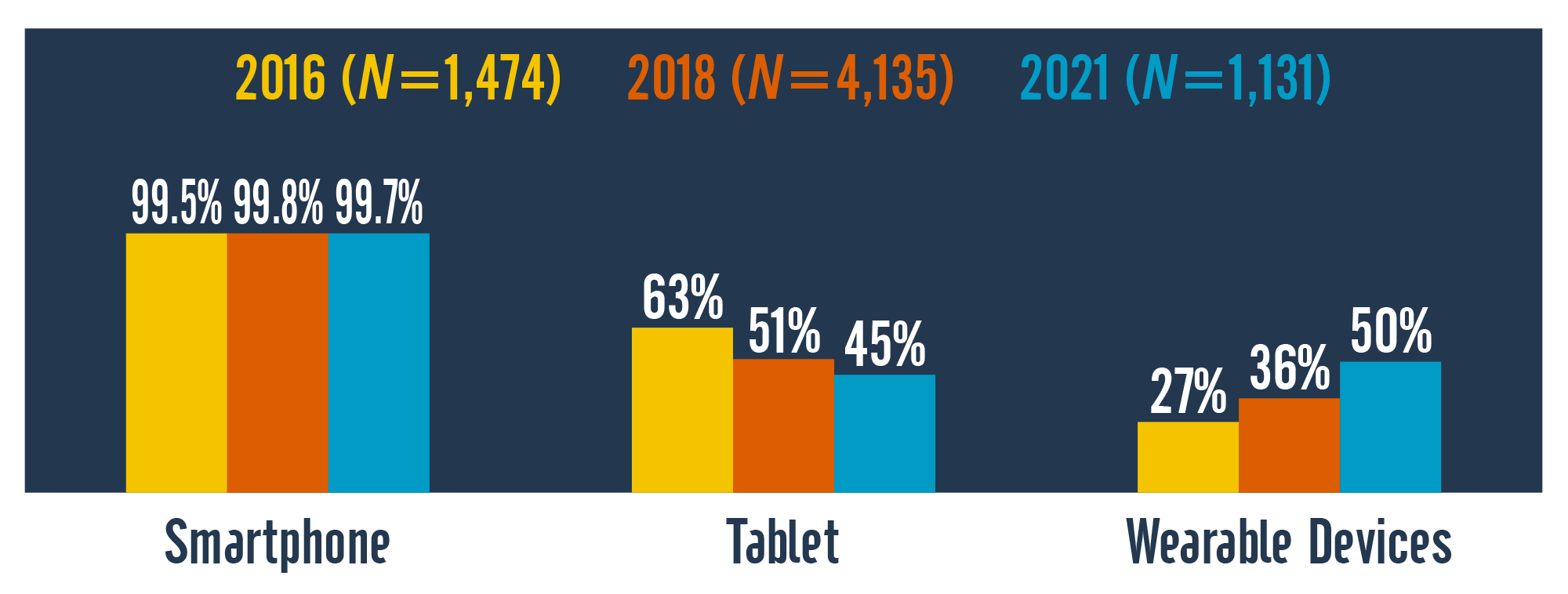
As figure 2 shows, essentially all UCF students in 2021 owned at least one of the two prominent smartphone devices: iPhone (85 percent) or Android (15 percent), with "other" accounting for just 0.3%. These two devices were prominent across the survey years, though iPhone ownership has increased (16 percentage points), while Android ownership has gradually declined (12 percentage points), and any device other than that has practically disappeared.
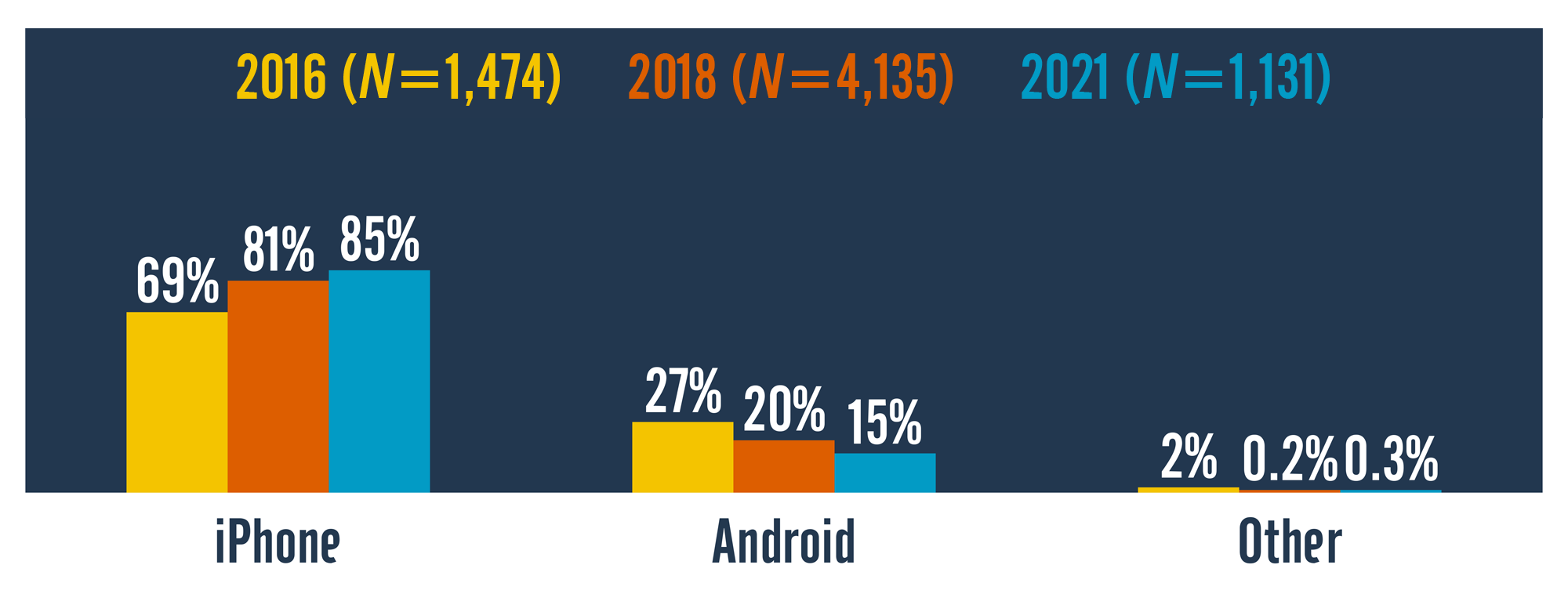
In 2021, tablet ownership was at 45 percent overall, with most students owning at least one iPad (33 percent) or Android tablet (6 percent). Tablet ownership decreased across device types over the years (see figure 3), with Android experiencing a larger decline than Apple.
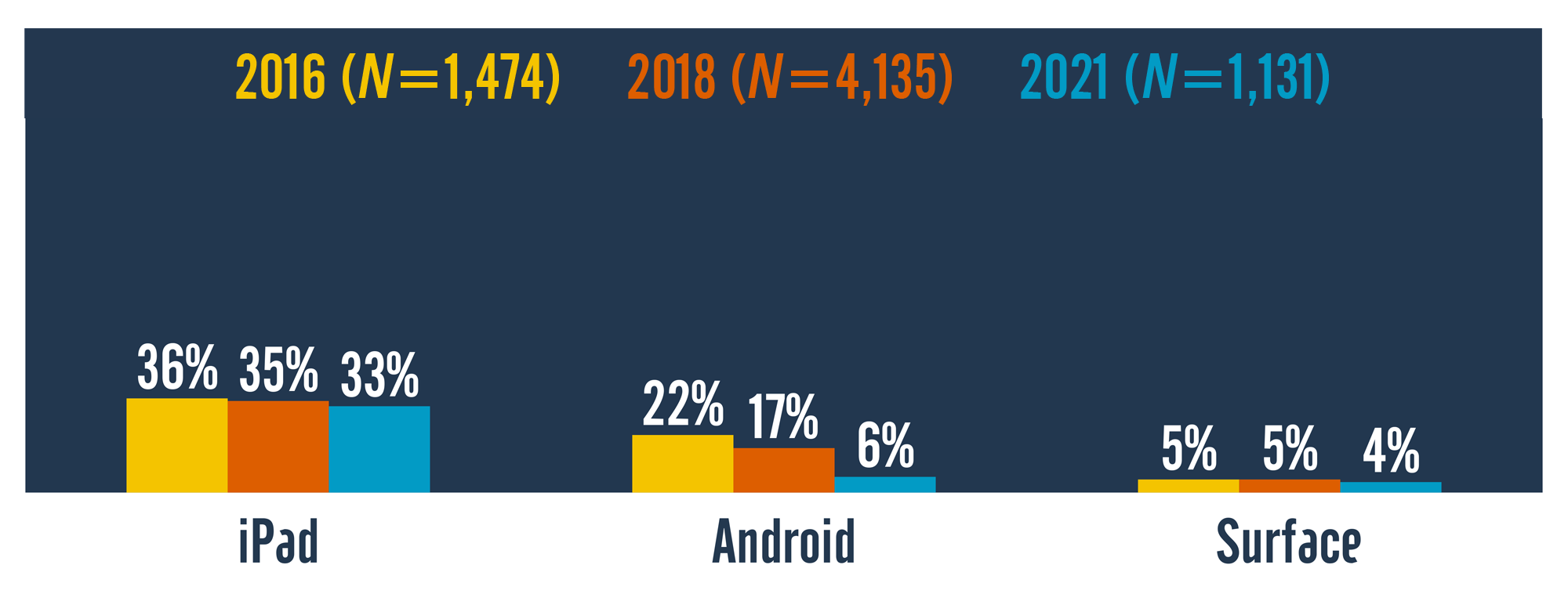
Wearable device ownership increased over time, with 56 percent of students (n = 631) owning one in 2021 (an increase of 23 percentage points since 2016). As figure 4 shows, the most common wearable devices were Apple Watch (38 percent) and Fitbit (7 percent). Apple Watch ownership has increased over time (34 percentage points since 2016), while ownership of Fitbit and other devices dropped in 2021.
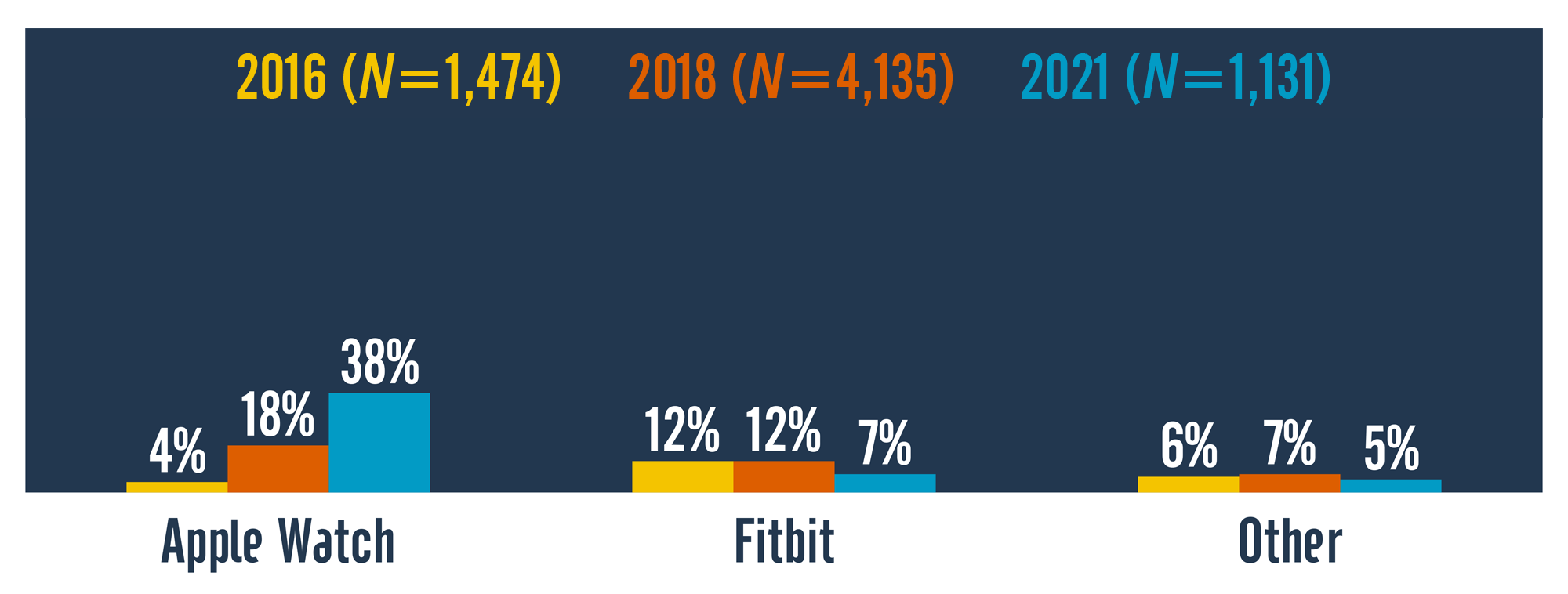
Device Usage
Research Question 2: How do students use mobile devices and apps, and how has that usage changed over time?
Results across the three surveys indicate that most students are actively using their smartphones for learning purposes, while tablet use has declined (see figure 5). In 2016, 82 percent of students (n = 1,204) used their smartphone and 38% (n = 566) used a tablet at least once a week for learning activities, such as reading, studying, or completing an assignment. In 2018, 87 percent (n = 3,601) said they used their smartphone for learning at least once a week, while tablet use had dropped to 26% (n = 1,089). In the 2021 survey, 81 percent (n = 912) said that they used their smartphone at least once a week for learning, which is a drop from the 89 percent reported three years earlier. Only a quarter of the 2021 respondents used tablets for learning at least once a week. Laptops remain the most utilized device to support learning. Interestingly, 61 percent of students reported using a smartphone for learning more than normal during the COVID-19 pandemic, and 91 percent of students reported using a laptop/desktop for learning more than normal.
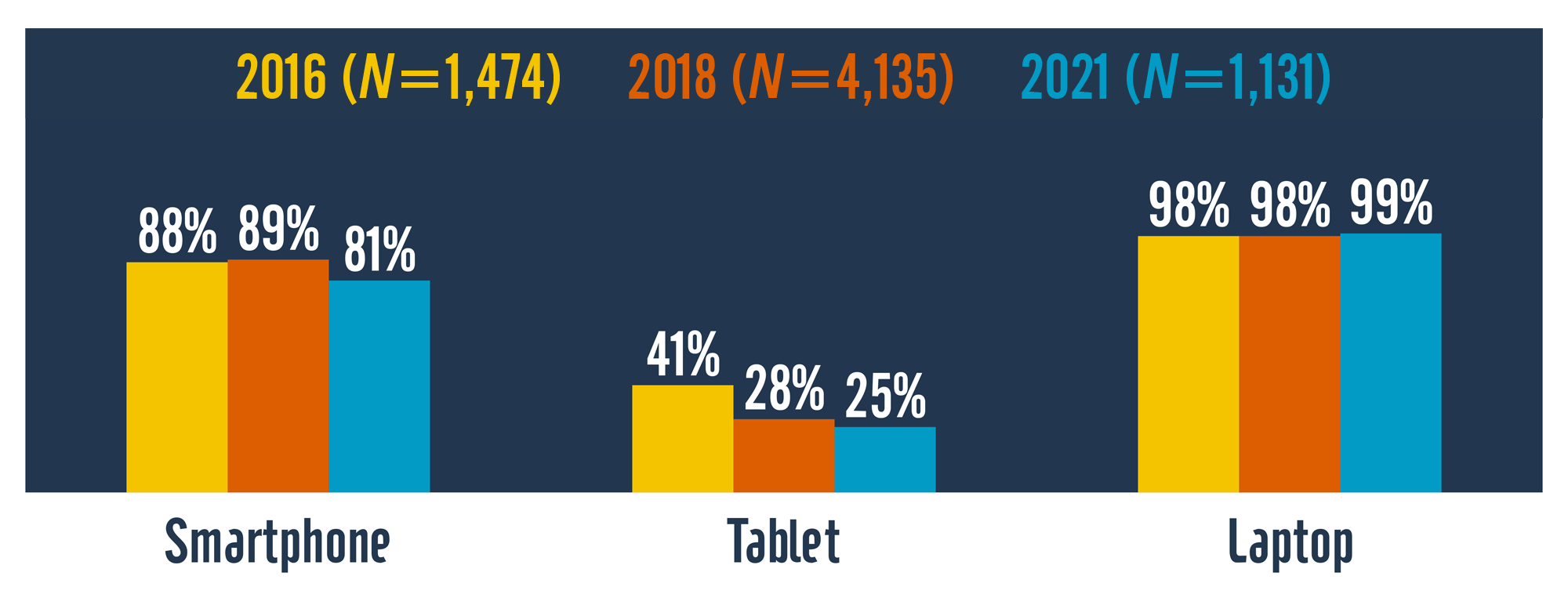
Table 2 displays the top three learning apps that students reported using: Canvas Mobile (n = 1,016), UCF Mobile (n = 932), and Zoom (n = 833). The use of Canvas Mobile in 2021 increased to 91 percent of the respondents from 87 percent in 2016, and the use of UCF Mobile in 2021 increased by 5 percentage points. Compared with the previous two surveys, Zoom was a new app that 74 percent of students reported using extensively during the pandemic remote learning.
|
|
2016 | 2018 | 2021 |
|---|---|---|---|
|
Canvas Mobile |
87% |
90% |
91% |
|
UCF Mobile |
78% |
83% |
83% |
|
Zoom Mobile |
N/A |
N/A |
74% |
In 2021, 37 percent of students (n = 418) reported using the institutional mobile app (UCF Mobile) at least once a week. The UCF Mobile app is a portal to direct students to other academic apps and institutional resources; 52 percent (n = 587) rated their experience with the app extremely good or somewhat good.
Beliefs about Mobile Usage
Research Question 3: What are students' beliefs about the value of mobile usage, and how have those beliefs changed over time?
The 2021 survey showed little change in student beliefs about mobile technologies' value for academic work (see figure 6). The ratings for each subcategory fluctuated slightly over the years. About three-quarters of students agreed that mobile technologies made it easier for them to access coursework. Over 60 percent of students agreed that mobile technologies increased communications with other students and instructors. Approximately half of students agreed that mobile usage has improved their quality of coursework. One consistent trend is a peak in 2018 and a slight dip in 2021.
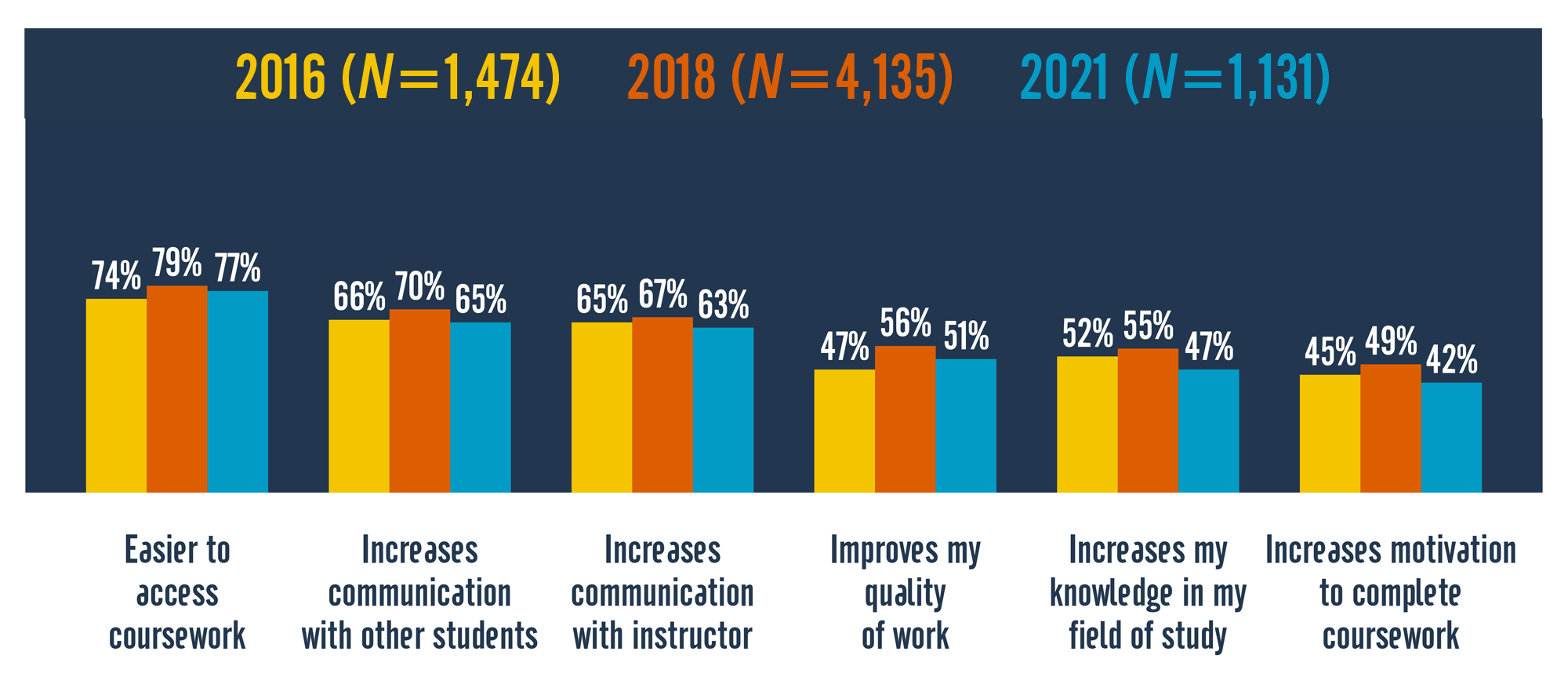
While our students voluntarily use their mobile devices for learning, they are ambivalent about the instructor role (see table 3). In 2016 and 2018, we asked students if they would like their instructors to use more mobile apps or devices in coursework. Given the largely remote context of the COVID-19 pandemic, the 2021 survey question was slightly refined to ask if they want instructors to ask students to use mobile apps or devices in coursework. Results remained even across the years.
| Survey Item | 2016 (want instructors to use apps) | 2018 (want instructors to use apps) | 2021 (want instructors to ask students to use apps) |
|---|---|---|---|
|
Yes |
38% |
42% |
36% |
|
No |
34% |
28% |
34% |
|
Not sure |
28% |
30% |
31% |
In 2016 and 2018, respondents were asked to identify reasons why they might not want their instructors to use mobile apps and devices for coursework. Limited internet connectivity and limited funds were among the most cited reasons. In 2021, only those students who answered No or Not Sure (n = 719) if they wanted instructors to ask them to use mobile apps or devices in coursework were probed for reasons. While items such as limited or no mobile device access, lack of technical support, and limited funds did not appear to be much of a problem for students in 2021, lack of interest certainly was; 53% of these students (n = 383) indicated that they would not want instructors to ask them to use mobile apps or devices more often in coursework because they did not have an interest in learning that way. We cannot directly compare the reasons with the previous two surveys since the question was phrased differently, but what is clear is that students in 2021 who were less inclined to go mobile for school expressed that lack of interest over other limitations. Whether that is because those options are no longer obstacles, or because they don't want faculty to ask, remains unclear.
Discussion
This article's purpose was two-fold:
- Report the results of our biennial campus technology survey
- Consider how trends have changed over the course of the most recent five years that these surveys have been conducted.
Several themes emerge, but results cannot be thoughtfully interpreted without acknowledging the great impact of the COVID-19 pandemic on students' lives. While the 2021 numbers show us some snapshots of what students were indicating just coming out of a pandemic lockdown situation, the numbers over the course of all five years shed some insight into how some technology trends have changed while others remained consistent.
The Evolving Nature of Mobile Device Ownership and Use
When the original survey was conducted in 2012, using mobile devices in academic learning situations was relatively novel. The first iteration of the iPhone had only been distributed to the general public five years prior and had 44.53 million American owners; by 2021, the ownership increased by almost three times to 116.3 million.Footnote14 Over the past five years, smartphone ownership in our survey has remained consistent at nearly 100%. Apple's iPhone dominates at 85%, and while that is a higher dominance than national trends, it also means that the mobile experience (Apple's iOS) is very similar across the overwhelming majority of our survey sample.Footnote15
Compared to a decade ago, mobile device use is ubiquitous. These devices, primarily the smartphone, are integral tools in personal, academic, and professional experiences. However, formal learning using mobile devices is not ubiquitous; some instructors even ban them from their classrooms. The national finding of students using laptops for their primary learning device and smartphones for their secondary device has changed little over the course of the past decade.Footnote16 The perceptions about the value of mobile technologies in learning have stagnated, and students appear ambivalent about instructors using them or having instructors ask students to use them. Why? The reason could be that mobile in education is no longer an innovation; it is a utility, something to be as expected as an LMS or a textbook. Students routinely use mobile devices for learning activities, such as checking emails, visiting Canvas online, searching for information, and checking schedules. And while students did point out that funding and connectivity issues contribute to their lack of interest, one possibility is that a greater number of students have experienced mobile learning and don't necessarily perceive the value in it. The value of mobile learning might be higher for students if they had a better understanding of mobile utilities in the context of education. Most students agreed that mobile devices afforded opportunities for both communication and access, but fewer agreed that mobile devices enhance their motivation or the quality of their work. This is consistent with our previous articles, which show students are content with small tasks via mobile rather than large ones.Footnote17 Students could also be faced with issues such as insufficient storage space, smaller screens, and connectivity concerns (in our 2021 survey, connectivity at home was listed as a major issue for nearly 10% of the respondents).
A short discussion is warranted about the drop in tablet ownership coinciding with the growth in wearable technology. While tablet ownership overall dropped over the past five years, the percentage of iPad ownership remained consistent in each survey, around 33–36%. The overall drop in tablet ownership is interesting in that it was once thought that e-books or other consumption uses might lead to a surge in these devices. However, the growing sizes of smartphone screens could have also contributed to the decrease. Given that many tablets require additional keyboard attachments to produce content effectively, students likely have determined their laptops are the better option for them. As for wearable technology, Apple Watch was by far the most popular wearable device in the 2021 survey. This Apple technology clustering could be a case of either environment or commerce. Some students may see these devices consistent with their iPhones or (for some) their iPads; others may have them simply because smartwatches have gotten cheaper. Regardless of the reason, it will be interesting to see if these remain simply personal notification devices or if manufacturers—and educators—look for ways to incorporate them into learning platforms beyond medical education or physical education studies.
The Evolving (Accelerated) Nature of Online Learning
The students in the 2021 survey were on lockdown for much of 2020, and likely their teachers were scrambling to find ways to deliver educational content. In the past, "online" typically meant asynchronous, module-based learning; the pandemic brought Zoom sessions, synchronous video classrooms, and atypical learning environments, all of which likely challenged mobile devices and applications. The efforts of instructors, while Herculean, might not have met the expectations of college students. As students spent more time on their laptops, they realized the difference in screen real estate, functionality, and speed. Using a mobile phone for learning is typically seen as utilitarian when "mobile" (e.g., "I need to get this done now") but perhaps less so when stationary. It is also possible that "mobile" was interpreted as a "mobile hotspot" for students who were trying to learn online in any way they could. During the COVID-19 pandemic, 61 percent of students reported using a smartphone for learning more than normal. However, this finding does not necessarily mean that students are consistently using smartphones more than ever. While 81 percent used their smartphone at least once a week for learning, 82 percent of students reported using laptops most in their academic lives to support learning. It appears that the laptop remains the primary learning device for students.
The growth of wearable ownership in our samples deserves a bit of discussion. We should point out, however, that our definition of "wearable" is limited to smartwatches and fitness trackers and does not include innovations such as AR glasses, virtual reality headsets, or other devices that are embedded in clothing (Nike+ Fitness) or the body (e.g., embedded headphones, GPS trackers). Research into wearables in physical education and medical education is growing, though it's not clear how notifications or heart-rate information would expand into other disciplines. Certainly studies that examine the disruptive effect of message notifications or alarms in classrooms could provide some insight, but there may be little growth in learning outcomes research. One possible connection may be using wearable data for the overall health of students, including physical and mental. As awareness of issues related to mental health and students continues to rise, fitness/sleep/activity trackers may be part of larger student-focused studies. Further still, the overuse of mobile devices by students, both for social and educational purposes, may warrant future study.
Using Mobile Skillfully
Designing academic experiences and activities with mobile learning in mind has been important from the beginning. One of the key takeaways from our first article in EDUCAUSE Review was this: "To improve mobile learning effectiveness, students and instructors need help adopting more effective learning and teaching practices across content areas."Footnote18 This takeaway remains true a decade later. The sudden shift to emergency remote teaching in 2020 illuminated that need even more.
Our call from previous articles remains consistent: that faculty deserve training to effectively craft assignments and lessons with mobile platforms in mind. It may be easy to see how mobile devices are used in classes such as mobile journalism or social media studies; not so for classes such as advanced mathematics or chemistry. Rather than creating blanket training for all instructors, a better use of time could be to focus on specific disciplines and prepare students to use mobile technologies in their fields, such as hospitality, medicine, or journalism. While the lesson—not the technology—should always come first, it is important to help faculty find ways to use this ubiquitous tool to help students learn and process information. In our 2021 survey, students reported a stagnation in beliefs about the value of mobile learning and ambivalence about instructor use of mobile devices. One reason may be burnout: they don't want another screen to work on. Another may be that they struggled to use new, advanced functions (e.g., video chat, module progression, quiz functions) in academic apps developed during the pandemic.
Conclusion
Our series of mobile surveys offers a systematic view of mobile device ownership and its implications for mobile learning practices at UCF. Our hope is that it might also help other institutions promote more systematically established mobile strategies of their own.
We intend to continue our mobile research and hope to continue to find support and best practices to take advantage of the widespread mobile ownership in the classroom and at the university as a whole. In doing so, we're driven by the following general questions:
- Why go mobile? Laptops dominate the educational device landscape, but the right tasks in the right classroom may be a perfect "mobile" fit. Knowing more about why students are drawn to mobile for more than personal uses will help us find out what educational uses work best.
- What is mobile's future post-pandemic? Lockdowns and social distancing forced changes in how we use technology for education, but what tools or techniques will stay with us when things are "back to normal"?
- Does mobile help speed up the change in higher education and in college students? Many students at UCF work and/or have families, and more students have gained access to education because of changes in delivery brought on by the pandemic. Mobile can help us deliver content to where they are; what kind of content should that be?
While it may be tempting to look at variations in results after a pandemic lockdown, it's very important to look at these findings in the context of what educators accomplished during that same time: delivering content through many different channels. Students are telling us what they prefer when it comes to mobile learning and access. The more we listen, the more effective we can be.
Notes
- Ryan Seilhamer, Baiyun Chen, Sue Bauer, Ashley Salter, and Luke Bennett, "Changing Mobile Learning Practices: A Multiyear Study 2012–2016," EDUCAUSE Review, April 23, 2018; Baiyun Chen, Ryan Seilhamer, Luke Bennett, and Sue Bauer, "Students' Mobile Learning Practices in Higher Education: A Multi-Year Study," EDUCAUSE Review, June 22, 2015; and Baiyun Chen and Aimee deNoyelles, "Exploring Students' Mobile Learning Practices in Higher Education," EDUCAUSE Review, October 7, 2013. Jump back to footnote 1 in the text.
- Seilhamer, Chen, Bauer, Salter, and Bennett, "Changing Mobile Learning Practices: A Multiyear Study 2012–2016," and Chen, Seilhamer, Bennett, and Bauer, "Students' Mobile Learning Practices in Higher Education: A Multi-Year Study." Jump back to footnote 2 in the text.
- Seilhamer, Chen, Bauer, Salter, and Bennett, "Changing Mobile Learning Practices: A Multiyear Study 2012–2016." Jump back to footnote 3 in the text.
- Petroc Taylor, "Market Share of Mobile Operating Systems in North America from January 2018 to January 2023" Statista, January 17, 2023. Jump back to footnote 4 in the text.
- Dana Gierdowski, "Student Experiences with Connectivity and Technology in the Pandemic," Research Report (Boulder, CO: EDCAUSE, April 2021); and Dana Gierdowski, Christopher Brooks, and Joseph Galanek, "2020 Student Technology Report: Supporting the Whole Student," Research Report (Louisville, CO: EDCAUSE, October 2020). Jump back to footnote 5 in the text.
- Gierdowski, Brooks, and Galanek, "2020 Student Technology Report: Supporting the Whole Student." Jump back to footnote 6 in the text.
- Andrew Perrin, "Mobile Technology and Home Broadband 2021," Pew Research Center, June 3, 2021. Jump back to footnote 7 in the text.
- Jenay Robert, "EDUCAUSE QuickPoll Results: Flexibility and Equity for Student Success," EDUCAUSE Review, November 5, 2021. Jump back to footnote 8 in the text.
- Gierdowski, "Student Experiences with Connectivity and Technology in the Pandemic." Jump back to footnote 9 in the text.
- Alexander Kunst, "Wearable Device Ownership in Selected Countries 2021," Statista, February 23, 2022. Jump back to footnote 10 in the text.
- S. Adams Becker, M. Cummins, A. Davis, A. Freeman, C. Hall Giesinger, and V. Ananthanarayanan, "NMC Horizon Report: 2017 Higher Education Edition" (Austin, TX: The New Media Consortium, 2017). Jump back to footnote 11 in the text.
- Dana Gierdowski, "ECAR Study of Undergraduate Students and Information Technology, 2019," Research Report (Louisville, CO: EDCAUSE, October 2019). Jump back to footnote 12 in the text.
- Gierdowski, "Student Experiences with Connectivity and Technology in the Pandemic." Jump back to footnote 13 in the text.
- Federica Laricchia, "Apple IPhone Smartphone Users in the United States 2012–2022," Statista, October 18, 2022. Jump back to footnote 14 in the text.
- Taylor, "Market Share of Mobile Operating Systems in North America from January 2018 to January 2023." Jump back to footnote 15 in the text.
- Robert, "EDUCAUSE QuickPoll Results: Flexibility and Equity for Student Success" and Gierdowski, "Student Experiences with Connectivity and Technology in the Pandemic." Jump back to footnote 16 in the text.
- Seilhamer, Chen, Bauer, Salter, and Bennett, "Changing Mobile Learning Practices: A Multiyear Study 2012–2016." Jump back to footnote 17 in the text.
- Chen and deNoyelles, "Exploring Students' Mobile Learning Practices in Higher Education." Jump back to footnote 18 in the text.
Baiyun Chen is Senior Instructional Designer at the Center for Distributed Learning at the University of Central Florida.
Aimee deNoyelles is Senior Instructional Designer at the Center for Distributed Learning at the University of Central Florida.
Tim Brown is Associate Professor of Media and Journalism in the Nicholson School of Communication and Media at the University of Central Florida.
Ryan Seilhamer is Product Owner of Penn State Go Mobile and Web at Penn State University.
© 2022 Baiyun Chen, Aimee deNoyelles, Tim Brown, and Ryan Seilhamer. The text of this work is licensed under a Creative Commons BY-NC-ND 4.0 International License.
